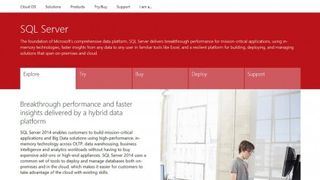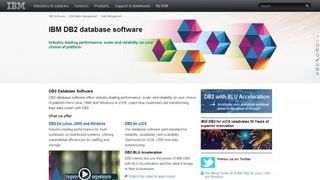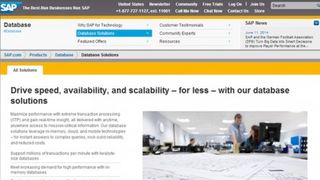Database management software: top four on the market
Platforms for maximising database value
Microsoft SQL Server
SQL Server is Microsoft's database offering. It is one of four DBMS platforms that sits in the leaders segment of Gartner's "Magic Quadrant for Operational Database Management Systems". Gartner cites its strengths as its market vision and capabilities, competitiveness within the DBMS market, its performance and the support offered. The areas which are cautioned about are a lack of appliances and pricing.

SQL Server can be managed on premise, in the cloud or in a hybrid environment. Amongst the platform's benefits, according to Microsoft, are "breakthrough, in-memory performance" with an average of a 10x gain for transaction processing with existing hardware and over 100x gain for data warehousing.
The platform is also said to offer high levels of availability and scalability of up to 640 logical processors for physical processing or up to 64 logical processors for virtual machines.
In addition to its performance and deployment benefits, SQL Server is also recognised for its security credentials. Last year, the platform was shown to have been the least vulnerable database for five years in a row by the National Institute for Standards and Technology's Comprehensive Vulnerability Database.
IBM
IBM software joins Oracle and Microsoft's offerings in the leaders segment of Gartner's "Magic Quadrant for Operational Database Management Systems" with its DB2 and Informix platforms. Gartner praises IBM for the broad functionality it provides, its hardware integration and global presence. It cautions against the provider's complexity and pricing, its confusing branding and poor sales execution with "very aggressive competitor marketing."

For users of its products, IBM promises industry-leading performance across multiple workloads, whilst providing reduced administration, storage, development and server costs. DB2 focuses on scalability and reliability and can be used with Linux, UNIX, Windows and z/OS operating systems.
The Informix database server, meanwhile, offers real-time analytics, fast always-on transactions, sensor data management and NoSQL capability.
Are you a pro? Subscribe to our newsletter
Sign up to the TechRadar Pro newsletter to get all the top news, opinion, features and guidance your business needs to succeed!
SAP
SAP is the final provider in the leaders segment of Gartner's "Magic Quadrant for Operational Database Management Systems". Gartner praises its vision leadership, strong DBMS offerings and the performance of those offerings. It urges caution regarding the company's marketing communications, the lack of skills available in the market for its DBMS products and its poor provision of support.

SAP is another provider with multiple database offerings, including HANA and Sybase, which it acquired in 2010.
According to IBM, HANA allows users to analyse data in real-time, processing both operational and analytical data in a single in-memory database. It promises near-zero latency, built-in predictive analytics and the ability to create custom applications.
Sybase, meanwhile, is targeted for use in financial markets and focuses on allowing users to combine real-time data capture, historical analytics, and risk management. It promises support for the entire trading lifecycle, along with the ability to develop, test and execute risk management and trading processes and analytics for market data.
